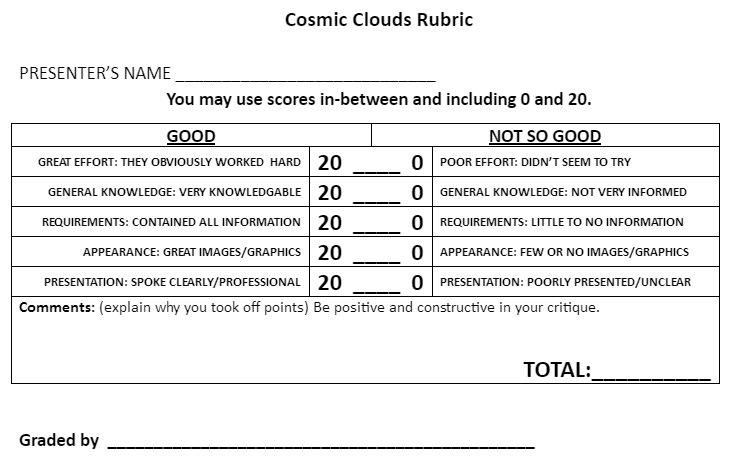-
Cosmic Clouds!
Directions
- Finding your favorite Nebula!
- Use the links below to discover your favorite two Nebulae!
- Please choose from the following types of nebula (they should be different types).
-
- Planetary Nebula
- Supernova Remnant Nebula
- Dark Nebula
- Emission Nebula
-
- Reserve your Cosmic Clouds!
- Once you have found your favorite nebulae, comment on today's post with their names and types.
- The first one to reserve their Cosmic Clouds has those phenomena!
- If you want to change your Cosmic Clouds, comment on the post to update your change.
- Be careful, as some of these nebulae may have multiple names.
- No two students can have the same nebula, so look through the reservations carefully.
- Investigate your Cosmic Clouds!
- Take detailed notes about your nebulae in your journal.
- Research: Your nebulae
- Name of your Nebulae
- Type of Nebulae
- How your Nebulae Formed
- Location, distance from Earth, and any other interesting facts you uncover.
- Website Investigation Resources
- https://www.eso.org/public/images/archive/category/nebulae/
- https://esahubble.org/images/archive/category/nebulae/page/2/
- https://noirlab.edu/public/images/archive/category/nebulae/
- Supernova Nebula: https://chandra.harvard.edu/photo/category/snr.html
- Planetary Nebula: https://web.williams.edu/Astronomy/research/PN/nebulae/
- Dark Nebula: https://www.constellation-guide.com/category/dark-nebula/
- JWST Nebula: https://webbtelescope.org/images?Category=04-nebulas&itemsPerPage=15&page=1
- Feel free to use Google search, but be careful that your information is correct. Ask if you need guidance.
- Present your Nebulae!
- Focus on presenting the key properties of your nebulae.
- Your presentation should be between 5-10 minutes in length.
- You may present your nebulae in any of the following ways.
- Google Slides Presentation
- Poster Presentations
- Video Presentation
- Include charts, data graphs, and other visual information to help us understand your phenomena more.
- Assessments!
- You will be graded using a rubric by your peers.
- You will be able to self-assess your project/presentation.
- Your teacher will determine your final grade based on the above assessments.

Project Rubric:
Criteria Exemplary (4) Proficient (3) Developing (2) Needs Improvement (1) Points Research Quality All research components (type, size, location, features, workings, interesting facts) are accurate, detailed, and well-explained. Most research components are accurate and well-explained, with minor omissions or lack of detail. Some research components are included but lack detail or accuracy. Research is incomplete or inaccurate, with little effort shown. /4 Google Slides Design Slides are visually appealing, with clear organization, readable text, relevant images, and creative design. Slides are organized and visually appealing, with minor issues in readability or design. Slides are somewhat disorganized, with limited visuals and poor readability. Slides are disorganized, difficult to read, and lack visuals or effort. /4 Presentation Skills Student speaks clearly, confidently, and engages the audience; minimal reliance on notes. Student speaks clearly and confidently, with moderate reliance on notes. Student reads directly from slides or notes, with minimal audience engagement. Student is difficult to hear, unprepared, or disengaged. /4 Understanding Demonstrates in-depth understanding and answers questions confidently and accurately. Demonstrates good understanding and answers most questions accurately. Demonstrates limited understanding and struggles to answer questions. Demonstrates little to no understanding and cannot answer questions. /4 Creativity and Effort Presentation reflects exceptional effort, creativity, and thoughtfulness in research and design. Presentation reflects good effort and thoughtfulness, with some creative touches. Presentation shows some effort but lacks creativity or depth. Presentation shows minimal effort, with little thought or creativity. /4
Grading Scale
- 16-20 points: Outstanding
- 11-15 points: Satisfactory
- 6-10 points: Needs Improvement
- 0-5 points: Unsatisfactory
- Finding your favorite Nebula!

